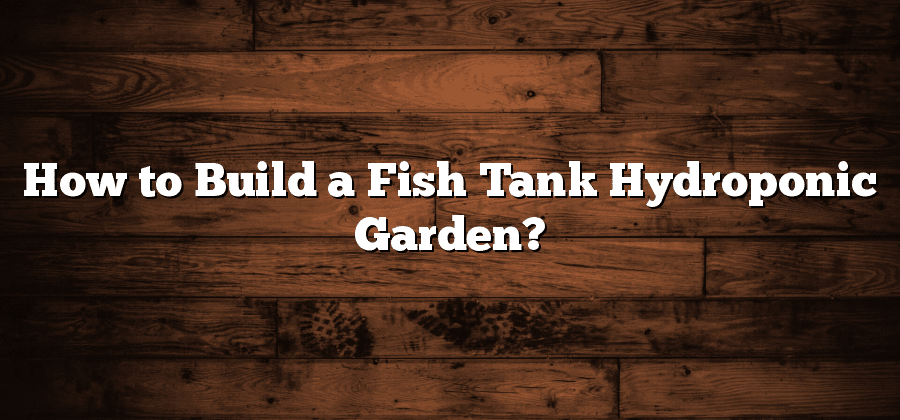Selecting the Ideal Fish Tank for Hydroponic Gardening
When it comes to hydroponic gardening, selecting the right fish tank is crucial for the success of your plants. The fish tank serves as the foundation of your hydroponic system, providing a home for your fish and a reservoir for your nutrient-rich water. One important factor to consider is the size of the fish tank. The size of your tank will depend on the space you have available and the number of plants you plan to grow. A larger tank will provide more stability in terms of water volume and temperature fluctuations, but it may also require more maintenance and resources. On the other hand, a smaller tank will be easier to manage but may limit the number and size of plants you can grow.
Understanding the Basics of Hydroponic Gardening
Hydroponic gardening is a modern and innovative method of growing plants without soil. Instead, plants are nurtured by a nutrient-rich water solution that is directly delivered to their roots. This method offers numerous advantages, including increased growth rates, higher yields, and the ability to grow plants in areas with limited access to traditional gardening methods.
One of the key components of hydroponic gardening is the water solution, which acts as the medium for delivering nutrients to the plants. This solution is carefully balanced to provide all the essential nutrients required for healthy plant growth. By directly providing nutrients to the roots, plants are able to absorb them more efficiently, promoting vigorous growth and development. Additionally, the absence of soil significantly reduces the risk of soil-borne pests and diseases, making hydroponic gardening a more sustainable and environmentally friendly option.
Determining the Right Plants for Your Fish Tank Hydroponic Garden
Determining the right plants for your fish tank hydroponic garden is a crucial step in ensuring the success of your project. The plants you choose will depend on various factors such as their compatibility with the hydroponic system, their nutrient requirements, and their ability to thrive in an aquatic environment.
When selecting plants, it is important to consider their growth rate and size. This will help you determine the spacing requirements and the number of plants that can be accommodated in your fish tank. Additionally, consider the nutritional needs of the plants and ensure that they can be adequately met by the fish waste in the water. Some popular choices for fish tank hydroponic gardens include lettuce, herbs like basil and mint, and leafy greens such as spinach and kale.
Remember, researching and consulting experts in hydroponic gardening can provide valuable insights into the best plant choices for your fish tank. By carefully selecting the right plants, you can create a thriving hydroponic garden that not only benefits your fish but also provides you with an abundance of fresh and nutritious produce.
Setting Up the Water Circulation System
Proper water circulation is crucial for the success of any hydroponic garden. It ensures that essential nutrients are evenly distributed to the plant roots and that waste byproducts are efficiently removed. To set up the water circulation system, start by selecting an appropriate pump. It should have sufficient power to pump water throughout the entire hydroponic setup without creating excessive pressure that could damage the delicate roots. Placing the pump in a central location within the fish tank or water reservoir is recommended for optimal water flow.
Next, it’s important to consider the design and placement of the watering tubes or pipes. These should be positioned in a way that allows water to reach all the plants evenly. One common method is to use a drip system, where small tubes with tiny holes are placed near the plant roots. This allows a steady stream of nutrient-rich water to be supplied, promoting healthy plant growth. Alternatively, an ebb and flow system can be employed, where a timer-controlled pump floods the growing medium periodically, and then drains it back into the fish tank. Whichever method is chosen, ensuring proper water circulation is essential for providing the necessary oxygen and nutrients to your hydroponic garden.
Choosing the Correct Lighting for Optimal Plant Growth
When it comes to hydroponic gardening, choosing the correct lighting is crucial for optimal plant growth. The right kind of lighting can mimic the natural sunlight conditions that plants need for photosynthesis. This means that you need to ensure that your plants receive the right amount of light throughout the day.
The first thing to consider is the type of lighting that you will use. There are several options available, including fluorescent lights, LED lights, and high-intensity discharge (HID) lights. Each type has its own advantages and disadvantages, so it’s important to weigh your options and choose the one that best suits your needs. Additionally, you should consider the wattage and color temperature of the lights. Different plants have different light requirements, so it’s important to do your research and ensure that the lights you choose provide the right spectrum of light for your specific plants.






